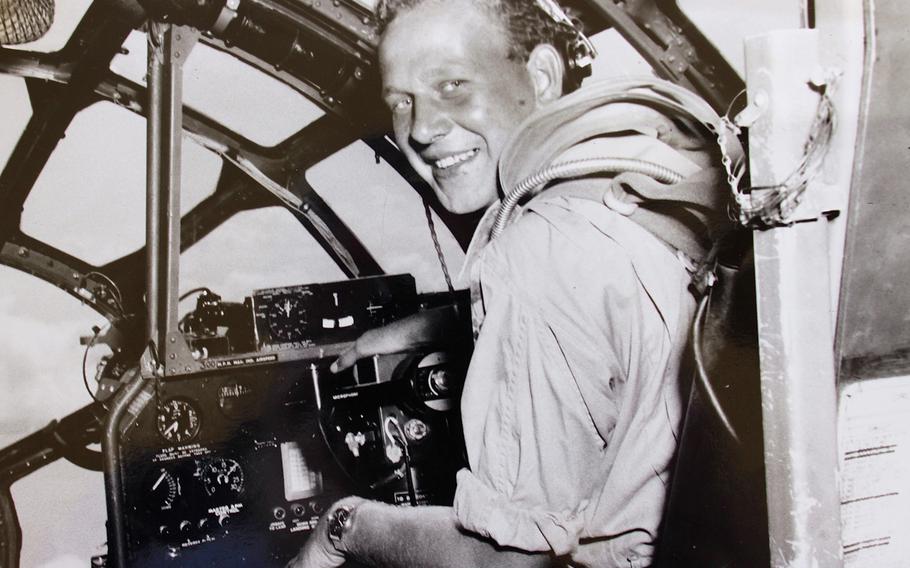
Raymond "Speedy" Biel, shown here in the B-29 during World War II, spoke to Marines on Wednesday at Marine Corps Recruit Depot San Diego. Biel, now 92, was a co-pilot for the bomber, and flew in one of the weather planes during the bombing of Hiroshima. (Photo courtesy of Raymond Biel)
SAN DIEGO — Second Lt. Raymond “Speedy” Biel knew he was participating in a top-secret mission on Aug. 6, 1945, when, as a co-pilot of a B-29 Superfortress, he flew over Nagasaki, Japan, to report the weather.
But it wasn’t until he returned to the island of Tinian that he learned the mission was to drop an atomic bomb.
On Wednesday, Biel told Marines at Marine Corps Recruit Depot San Diego the story of how he ended up participating in both of the missions to drop atomic bombs on Japan, effectively ending World War II.
Born in Chicago, Biel graduated from high school in 1940 and followed his girlfriend to college in Michigan. He was a freshman when Japan attacked Pearl Harbor, and he soon enlisted in the U.S. Army Air Force to avoid being drafted, he said.
Though he originally was told he would be able to finish college, Biel, 92, said his “deferment was deferred,” and he was sent to flight school. He was chosen to be a co-pilot on a new kind of plane, the B-29, and sent to Fairmont, Neb., where training facilities and runways had been hastily built.
Just before the B-29s finally arrived, Biel’s pilot gave him the plane’s manual, which was “about the size of a phone book.” Biel got his call sign when he delivered the book back to the pilot three days later, and the pilot marveled at how quickly the young lieutenant had read it.
Col. Paul Tibbets — the pilot whose plane, the Enola Gay, dropped the bomb on Hiroshima — chose 15 crews from Nebraska for the secret mission and took them to Wendover, Utah. After training in the desert and in Cuba, the crews began shipping out to Tinian, a tiny island some 100 miles north of Guam.
Tinian had been secured by the Marines in the late summer of 1944, and the Japanese had been building an airfield when the battle began. By August 1945, the airfield on Tinian was the busiest in the world, Biel said, with planes taking off every minute from each of the four runways.
On Aug. 6, Biel’s plane and two others started off low — around 2,500 feet — then began climbing to 30,000 feet once they reached Iwo Jima, he said. The three weather planes recorded the atmospheric conditions, and all three potential targets were clear. Three other planes went to Hiroshima to deliver the bomb; one additional plane was parked on Iwo Jima as a backup.
When the planes returned to the airfield, Biel said, they were told about the atomic bomb, and Tibbets was awarded the Distinguished Flying Cross on the spot.
Three days later, Biel was in the backup plane parked on Iwo Jima while six other B-29s flew to Japan. They first flew to Kokura, the site of one of Japan’s largest munitions plants, but the weather was cloudy, Biel said. After circling for about an hour, the planes decided to go to the secondary target, Nagasaki.
Nagasaki was also cloudy, Biel said, and the pilots had decided to use radar to drop the bomb, but just before they did, a hole appeared in the clouds. The plane dropped the bomb there, missing the original target by about three miles, he said. Later, the men found out that if they had hit the planned target, they would have destroyed a prisoner of war camp, killing 12,000 British prisoners.
At the time, Biel said he and the rest of the crew of his plane was sitting on Iwo Jima, worried. After three hours, they heard that the plane had landed on Okinawa and immediately run out of fuel. Two of the plane’s engines died on the runway, he said.
Though Biel didn’t know before the first mission what kind of bomb they would be dropping, he said he and the other airmen were happy when they found out the details, because they “knew the war was going to end.”
Retired Navy Capt. Richard Suttie, a friend of Biel’s who served as an interviewer at the event, said an invasion of Japan had already been planned, in case the bombing did not prompt Japan to surrender, and that casualties for that attack were expected to be around 80 percent.
Col. Mark Tull, commander of Headquarters and Service Battalion at the recruit depot, told the Marines the Japanese had sworn to “fight to the last man,” and that the planned landings would have involved 40 divisions.
“Those weapons saved lives,” Tull said, “and frankly, saved the world.”
hlad.jennifer@stripes.com Twitter: @jhlad